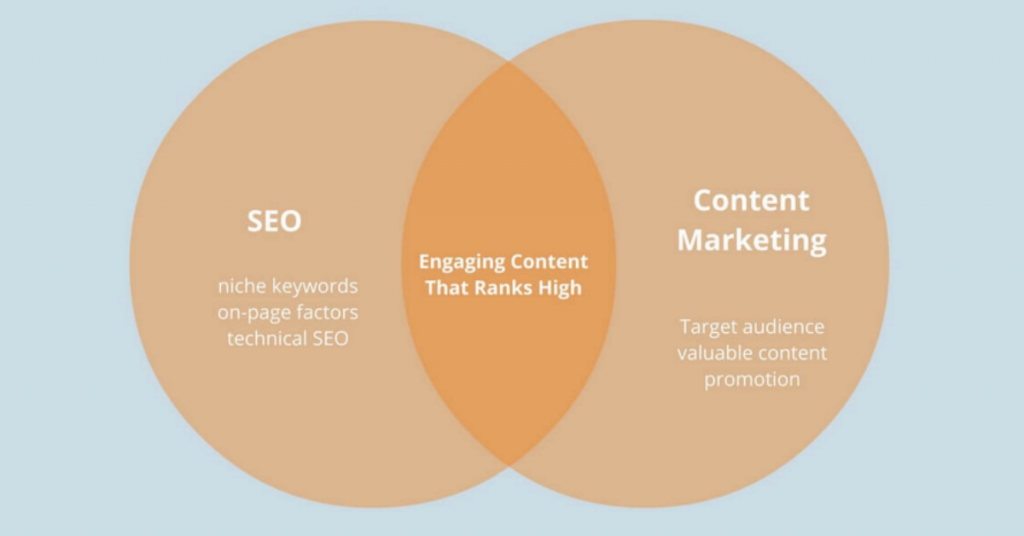In today’s competitive digital landscape, businesses are constantly looking for ways to increase their visibility on search engines and attract organic traffic. The combination of SEO (Search Engine Optimization) and content marketing is one of the most powerful strategies to achieve this goal. When executed correctly, SEO and content work together to improve search engine rankings, drive relevant traffic to websites, and create valuable user experiences. In this article, we’ll explore how SEO and content complement each other and the best practices to dominate search results with this dynamic duo.
Understanding SEO and Content Marketing

SEO refers to the process of optimizing your website to rank higher in search engine results pages (SERPs). This involves various techniques, such as keyword optimization, improving page speed, and obtaining high-quality backlinks, which help search engines like Google understand and rank your website’s relevance to specific search queries.
On the other hand, content marketing focuses on creating and sharing valuable, relevant content to engage your target audience. Whether it’s blog posts, videos, or infographics, content marketing aims to provide users with information that answers their questions and meets their needs.
While SEO and content marketing are distinct strategies, they work hand in hand to enhance visibility and engagement. Let’s dive deeper into how these two elements come together to improve search rankings and online presence.
The Role of SEO in Content Strategy
Keyword Research: The Foundation of Content Creation
Keyword research is the first step in creating content that ranks well on search engines. Without understanding what your target audience is searching for, your content may miss the mark. By identifying the right keywords to target, you ensure that your content addresses the specific needs of your audience.
How to Fix It
Use SEO tools such as Google Keyword Planner, SEMrush, or Ahrefs to discover high-volume, relevant keywords related to your niche. Once you have your list of keywords, incorporate them naturally into your content—this includes your headlines, subheadings, meta descriptions, and throughout the body text.
Avoid keyword stuffing, which can harm your rankings. Instead, focus on creating high-quality content that provides value while naturally integrating keywords. Additionally, consider targeting long-tail keywords, which are less competitive and more specific, improving your chances of ranking higher for niche topics.
On-Page SEO: Optimizing Content for Search Engines
On-page SEO plays a crucial role in ensuring that your content is easily discoverable by search engines. This includes optimizing elements such as title tags, meta descriptions, headings, and images. These elements help search engines understand the context of your content and rank it accordingly.
How to Fix It
Ensure each piece of content is fully optimized for on-page SEO. Start with an engaging, keyword-rich title tag (less than 60 characters) and a compelling meta description (under 160 characters) that summarizes your content. Use H1 tags for your main title and H2 or H3 tags for subheadings. Break up long paragraphs to improve readability, and add relevant images with alt text that describes the content.
Another important aspect is the URL structure. Make sure your URLs are clean, concise, and include your target keyword.
Content-Length and Depth: Quality Over Quantity
Google values content that provides comprehensive answers to search queries. Lengthy, in-depth articles tend to rank higher than shorter ones because they offer more detailed information and satisfy user intent.
How to Fix It
Aim for content that is thorough and informative. While there is no fixed word count for SEO, articles between 1,000 and 2,000 words tend to perform well, especially when the content is well-researched and answers the user’s query in detail. Break your content into easily digestible sections, and provide clear, actionable insights. Don’t sacrifice quality for length—focus on delivering value to your readers.
The Importance of Content in SEO

User Experience (UX) and Engagement
Search engines like Google consider user experience as a ranking factor. If your content is not engaging or easy to navigate, users will leave your site quickly, which signals to search engines that your content may not be relevant or valuable. High bounce rates can negatively affect your rankings.
How to Fix It
Ensure your content is easy to read, navigate, and visually appealing. Use subheadings, bullet points, and short paragraphs to improve readability. Add multimedia such as images, videos, or infographics to enhance the content and make it more engaging. Include internal links to related articles on your website, keeping users engaged with your content longer and improving your site’s overall SEO.
Mobile Optimization: A Key Factor for Success
With more people accessing the web via mobile devices, it’s essential that your content is mobile-friendly. Google uses mobile-first indexing, meaning the mobile version of your site is prioritized when determining search rankings. If your content is not optimized for mobile, it may suffer in search engine rankings.
How to Fix It
Use responsive design to ensure your website adjusts seamlessly to different screen sizes. Test your content’s readability on mobile devices by using Google’s Mobile-Friendly Test tool. Make sure your text is large enough to read without zooming in, images load quickly, and CTAs (calls-to-action) are easy to click on smaller screens.
Building Authority with High-Quality Content
Content marketing helps build your website’s authority by providing value to your audience. When your content addresses the needs and questions of your target market, it establishes you as a credible source of information in your industry.
How to Fix It
Focus on producing high-quality, well-researched, and original content that offers a unique perspective. Regularly update your content to keep it relevant and accurate. In addition, include statistics, case studies, or expert opinions to back up your claims and improve the trustworthiness of your content.
How Content Supports Link Building and SEO
Attracting Backlinks: The Power of Shareable Content
Backlinks, or links from other websites to your content, are one of the most important ranking factors for SEO. Content that is informative, engaging, and shareable is more likely to earn backlinks from other websites, which in turn boosts your domain authority and search rankings.
How to Fix It
Create high-quality content that others in your industry would want to reference and share. Write guest posts, conduct interviews with experts, or create data-driven research that can serve as a valuable resource for other websites. The more valuable and relevant your content, the more likely it is that other websites will link to it.
Social Signals and Content Distribution
Although social media shares are not a direct ranking factor for Google, they play a significant role in increasing the visibility of your content. The more people share your content on platforms like Facebook, Twitter, and LinkedIn, the more exposure you’ll get, which can lead to higher traffic and more backlinks.
How to Fix It
Promote your content across various social media channels to reach a broader audience. Encourage your followers to share your content by including social sharing buttons and calls-to-action. Engaging with your audience on social media and responding to comments can also help amplify the reach of your content.
Conclusion
Combining SEO with content marketing is a powerful strategy to dominate search results and drive sustainable organic traffic. By following best practices for keyword optimization, on-page SEO, content creation, and user experience, you can create content that ranks well on search engines and resonates with your audience. Remember that SEO and content marketing are ongoing processes that require continuous optimization and adaptation to changing trends. By consistently delivering high-quality, engaging, and relevant content, you’ll be able to improve your search rankings and grow your online presence. Keep experimenting, testing, and refining your strategies to stay ahead in the ever-evolving digital landscape.

Leave a Reply